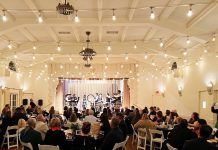The moth-balled East County Performing Arts Center, which has a small, ardent group of supporters in favor of re-opening the venue in time for the city’s November centennial celebration, may or may not cost millions to renovate—it depends on who you ask.
At a recent East County Performing Arts Center Foundation meeting, spokesman Ray Lutz continued to advocate reclaiming use of the venue as a centerpiece to the city’s downtown district.
The moth-balled East County Performing Arts Center, which has a small, ardent group of supporters in favor of re-opening the venue in time for the city’s November centennial celebration, may or may not cost millions to renovate—it depends on who you ask.
At a recent East County Performing Arts Center Foundation meeting, spokesman Ray Lutz continued to advocate reclaiming use of the venue as a centerpiece to the city’s downtown district.
“So many people don’t even know that the theater still exists, they’ve forgotten all about it,” Lutz said. “Re-opening it would be great for the arts community and develop the economic vitality of the area.”
The city of El Cajon and ECPAC representatives agree that the center should again become open to the public, yet each side notes different approaches to achieving that goal. Most notably, their differences revolve around funding.
“We need to put cops on the street before I put any performers on stage,” said Councilman Gary Kendrick. “All council members have said they want the center to open, but public safety comes first – it’s a matter of priorities.”
Lutz admits to problems to re-open ECPAC, which began operations in 1977, but was closed in December 2009 following mismanagement by several firms.
However, Lutz’ public meetings have drawn minimal support; his latest gathering saw less than two dozen attendees.
City officials have heard from the foundation on several occasions, but are concerned about the cost of making the building compliant with the Americans with Disabilities Act, along with repairing the center’s leaky metal roof, installing drinking fountains and air conditioning units, and upgrade concession area, to name but a few of the items that must be fixed.
The discrepancies focus on a 2009 report by professional consultant Kurt Swanson, who listed renovation costs exceeding $4.3 million, plus expenses to then operate the facility.
But the foundation issued it’s own report that estimated costs would be around $400,000, though even Lutz questions some of his group’s own numbers.
“I still need to look over the report because I know some of our numbers are bogus,” Lutz said. “That’s why we need people to volunteer to help.”
“We need to keep the city from tearing it down for a hotel.”
The potential demolition of ECPAC for a possible hotel site is a divisive point between the foundation and the city.
“We fully intend to open the theater at some point,” Kendrick said. “We want to dispel any rumors about ever tearing it down.
A key problem addressed in the Swanson Report is the roof, with an estimated repair cost of more than $800,000.
“It’s a metal roof except for a small area in the middle, but it would be fairly easy to fix —you just have to clean out the gutters,” Lutz said. “There’s a drain where (tree) needles collect, which was the cause of the leaking.”
Such differences help explain the city council’s recent status change from a wait-and-see attitude to determining the true repair costs in today’s dollars. The city recently came to an agreement with a neutral party to re-explore all repair issues.
“We just hired a couple of experts from a theater in Palm Desert,” Kendrick said. “They will examine the center, then write a full report to make a true determination.”
“We want the center to open, but in a way so it can be successfully.”
There are also discrepancies about how much it would cost to repair the center’s interior.
“The Swanson report said $300,000, but I don’t see where it could be more than $100,000,” Lutz said.
“For example, the orchestra lift was said to be completely non-functional, but I went down there — and I’m a electrical engineer —and I saw no corrosion whatsoever.”
Another point of contention is the foundation’s desire to become the new ECPAC operator, despite listing minimal professional qualifications to do so.
Lutz lists a Master’s degree from San Diego State University in the report’s executive summary. His father, Harold Lutz, founded the Grossmont Community Concerts Association in 1947, and at one time was band and orchestra director at Grossmont High School.
Again, Lutz seeks outside assistance with operations and to attract new money to raise the foundation’s $400,000 figure just to get the project off the ground.
There have been few takers and no financial backers have been designated by the foundation, which hopes to raise the needed funds through government grants—just not from local sources. Still, Lutz publicly states the foundation asks for no money from the city, yet the written proposal asks local government to cover many costs, including all utilities.
In the proposal, Appendix D on Page 53 expressly states, “Building repair should be borne by the City.”
In the executive summary, which was edited by Lutz and Bonnie B. Price, the foundation seeks to hold a “gala fundraising event this summer” to raise initial funds, yet wants the city to provide matching funds.
To date no plans for a gala have been made.
Plus, the Foundation plans to eventually “create specific projects that can be funded by the City,” in regards to educational and cultural programs. However, this idea was listed on Page 15 as a sub-set to “Required Direct Subsidy from the city of El Cajon: $0.”
“Even Kurt Swanson reported there are no public theaters in the country that can run without subsidies from the city,” Kendrick said.
City officials admit some taxpayer money will be needed, but the foundation’s own proposal seems unclear about the subject on actual costs and what should be covered..
“The financials (on renovations) from Swanson were crap, but his rental figures seemed to be right on,” Lutz explained. “But we also need to work around the governmental bottleneck. Fortunately, there are people who are going to run for office that support us.”
Lutz did not offer the names of any candidates who might support the foundation.
“I am concerned that some people may be misled thinking that Mr. Lutz will have a part in the re-opening of the theater,” added Kendrick. “Nothing can be further from the truth.”
Thus, the city is exploring other avenues for repairs and return the theater to operational status.
“The most important thing is the November elections and the governor’s proposed tax increase,” added Kendrick. “If it fails, the state may be taking money from the cities again.”














